“Is This an Opera Which I See Before Me?”
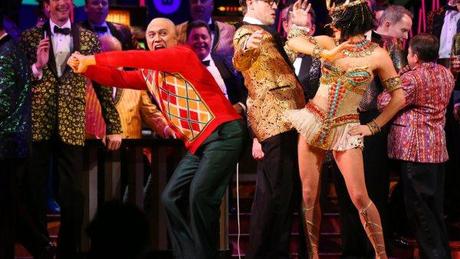
Dmitri Hvorostovsky as Rigoletto in Vegas (nytimes.com)
December 7, 2013 marked the start of the Metropolitan Opera’s 83rd consecutive season of live radio broadcasts of complete operas. To launch this yearly feast for the ears, listeners were treated to a revival of the company’s slam-bang, Las Vegas-style presentation of Giuseppe Verdi’s 1851 masterpiece Rigoletto, which we reviewed back in February when the production was spanking new (see the link: http://josmarlopes.wordpress.com/2013/02/16/a-ring-a-ding-ding-rigoletto-viva-las-vegas-at-the-met/. This was followed by the December 14 broadcast of the composer’s swan song Falstaff from 1893, in a lavish new production directed by Robert Carsen that sets this Shakespearean frolic in the vicinity of 1950s Windsor. Both works were played in purported “modern” dress — modern, that is, for the time periods in question.
In an earlier post, I discussed how Rigoletto anticipated Verdi’s later Un Ballo in Maschera (“A Masked Ball”), particularly in its deft handling of the Duke of Mantua’s debauched persona as opposed to that of the munificent monarch, King Gustavo of Sweden (or Riccardo, in the Boston setting). See the link: http://josmarlopes.wordpress.com/2012/12/15/un-ballo-in-maschera-verdis-a-masked-ball-regicide-on-the-radio/. Similarly, one can juxtapose the bawdy behavior of the fat knight, Sir John Falstaff, with that of the Duke’s acerbic court jester — in this case, a standup comedian-like Rigoletto. Both are prime candidates for representation by artists who’ve reached the pinnacle of their careers. The Met was indeed fortunate to have such artists at their disposal.
You’ll note that Shakespeare is mentioned not only in our title but in the opening paragraph to this essay. Although not actually based on any of the Bard’s plays, Rigoletto was Verdi’s most effective “Shakespearean” traversal to that time. His first stab at adapting one of the poet’s dramas for the lyric stage — an 1847 version of Macbeth, with a libretto by Francesco Maria Piave, the same poet who supplied the text for Rigoletto — did not exactly meet with critical approval. Subsequently, the demanding composer revised the work for Paris fourteen years later. Still, the critics complained. “It may be that I did not do Macbeth justice,” Verdi confessed to his French publisher, Léon Escudier, “but to say I do not know, do not understand and do not feel Shakespeare, no, by God, no! He is my favorite poet. I have known him from earliest youth and read and reread him continually.”
Despite this affirmation, Verdi’s “dream project” of a work based on the tragedy of King Lear would prove fruitless. Instead, the Italian master placed some of the preliminary sketches he had formerly outlined for Lear into the plot of his next subject: “I have in mind… one of the greatest creations that the theater of all nations and all times can boast. The story is Le Roi s’Amuse [‘The King Amuses Himself’], and the character I mean is Triboulet, a creation worthy of Shakespeare.”
The “King” in question was Francis I, who eventually took on the characteristics of the licentious Duke, while Triboulet, his jester, would be transformed into the sharp-tongued Rigoletto. Unlike any other character Verdi had hitherto worked on, Rigoletto is a cruel-minded, misshapen individual (with a hint of Richard III in his makeup) whose barbed gibes and verbal assaults earn the ire of everyone around him — with the notable exception of the jovial Duke, who keeps the smarmy hunchback at court for his own amusement. Rigoletto’s physical deformities, however, mask a warm and loving heart.
These traits are what attracted the theatrically savvy composer to write one of his most musically inspired scores. The specific connection to Shakespeare, moreover, can be traced to the jester’s passion for his daughter, the pure and innocent Gilda — somewhat akin to Lear’s idealized love for Cordelia. Rigoletto wisely keeps Gilda under lock and key and away from the Duke’s prying eyes. He is ultimately betrayed by the nobleman’s spiteful courtiers who kidnap Gilda and leave her to fend off the womanizing Duke’s advances on her own.
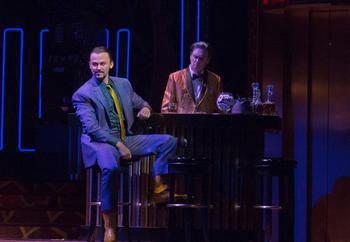
Stefan Kocan as Sparafucile (Ken Howard / Met Opera)
Humiliated by these turn of events, the jester seeks revenge by hiring a paid assassin, Sparafucile, to dispose of his wayward master. Unfortunately, a father’s curse levied on Rigoletto’s head leads to his downfall: in the end, he winds up a lonely, broken man, with his daughter breathing her last in his arms — similar to Lear’s fate with the dead Cordelia. In these surroundings good does not triumph over evil.
With Falstaff, Verdi and his librettist, the brilliantly gifted Arrigo Boito, did a complete about-face. To begin with, this was the composer’s first comedy since the failure of his second opera, Un Giorno di Regno (“King for a Day”), from half a century prior. In addition, Boito fleshed out the story by taking a character Shakespeare had lifted from English history and providing Verdi with bits and pieces from both parts of Henry IV, as well as brief borrowings of lines and situations from The Merry Wives of Windsor, to create a highly literate, bluntly Italianate, yet suitably immodest Sir John.
Although more than four decades separate the composition of Rigoletto from Falstaff, musically both works boast the lightness of touch favored by W. A. Mozart, along with the nimble comedic hand of Gioachino Rossini. The lovely minuet that figures prominently in the Duke’s wooing of the Countess Ceprano owes much to a comparable theme employed in Mozart’s Don Giovanni, while the marvelous massed concertato that ends Act II of Falstaff pays tribute to Rossini and his madcap Barber of Seville. Pays tribute, yes, but the end result is tutto Verdi — a nearly 80-year-old Verdi, at that.
“Laugh, Clown, Laugh”
With Rigoletto, the Bear of Busseto had reached a stage of development where both text and music would dictate the terms of the drama. “Emotional truth” was his catchphrase at the time, and no finer example of this “new style” exists than Rigoletto’s monologue, “Pari siamo” (“We’re both alike”), from scene ii of Act I. More an exercise in free association than a typical operatic showpiece, the jester’s mind seems to wander from subject to subject, as he first compares himself to the sinister Sparafucile, then darts back to the curse that was hurled at him at court; in the next instant he rages against humanity, while expressing resentment at his miserable lot in life. He finally dismisses these morose musings with the phrase, “Ah, no! È follia!” (“That’s madness!”). It’s a masterstroke of psychological probing and complexity rarely encountered in works of the day.
Obviously, only a singing-actor of the highest order can express all the various facets of personality this part demands. Singing the strenuous role of Rigoletto for the first time at the Met, Siberian-born Dmitri Hvorostovsky filled that bill completely and gave an object lesson in how to interpret character through visual and vocal means. Shorn of his thick mane of silver hair (a trademark of his), Hvorostovsky now sported a balding pate with a prominent comb-over, making look him like a rather tall Don Rickles. In one of the intermission features, the eloquent singer told listeners of a disagreement he had with director Michael Mayer over the interpretation of the title character. However, after having worked out the particulars, Hvorostovsky was convinced he could bring out his vision of the warped jester without overwhelming the strictly vocal aspects.
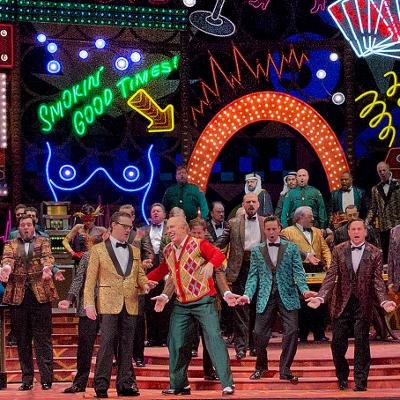
Act I of Rigoletto, set in Las Vegas (Ken Howard)
We’re glad he did, for his Rigoletto was a moving portrait in manic obsession. The fear and loathing of the courtiers, his desperation at the disappearance of his daughter, and the horrible realization of the tragedy he himself had brought to bear, were etched in primary colors: from the bronze-toned ravings of “Cortigiani, vil razza dannata!” and the tender shades of blue and gray in the “Piangi, piangi” duet with Gilda, to the blazing-hot outpourings of “Si, vendetta,” this Rigoletto encompassed all the elements of comedy and tragedy that have made this part a must for singers. Unlike his predecessor Željko Lučič, Dmitri was unsparing of his high notes, although some were a tad effortful — I’m thinking of the Act II finale (“Si, vendetta”) and the very end of the opera (“Ah, la maledizione!” – “Ah, the curse!”). Beyond that, this was a thoroughly convincing assumption of one of opera’s most challenging assignments.
As his daughter Gilda, debuting Bulgarian soprano Sonya Yoncheva displayed a Callas-like timbre, along with a fine feel for word values. The voice is not as large as Callas’, but it has the same dusky quality, particularly in the lower register. This could be used to advantage in heavier repertoire, but for now Gilda is a good starting point. Admittedly, Sonya held the coloratura fireworks in check throughout most of the afternoon, but as the popular “Caro nome” drew near, I detected some relief in her tone to the tune of “My time to show off has arrived,” and that she did, splendidly so. She and tenor Matthew Polenzani, as the tuxedo-sporting Duke, combined vocal suavity with first pangs of puppy love in their getting-to-know-you-number, “È il sol dell’anima.” For the first time in my experience, the duet ended with the original cadenzas as Verdi wrote them. They were most welcome.
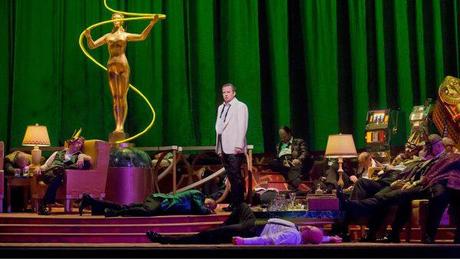
Matthew Polenzani as the Duke (Ken Howard / Met Opera)
The ending of the Duke’s Act II aria, “Parmi veder le lagrime,” also stressed the original cadenza, which is certainly better than the tacked on high notes some tenors seem to prefer. Polenzani stroked the phrases of this number ever so plangently. In fact, his soft singing throughout was a balm to the ears — most Dukes drain all the gentility out of this role, especially at “La donna è mobile.” Strangely, both he and Piotr Beczala, his predecessor in the part, ran aground in this same showstopper. Polenzani might have been having an off day, since his highest notes (including his attempt at a high D in “Addio, addio, speranza ed anima”) were evidencing extra labor. He recovered in time to convey a potent reading of the quartet.
Returning bass Štefan Kocán, as the stiletto-wielding hit man Sparafucile, lingered over his low F to much applause, while mezzo Oksana Volkova, as his morally loose sister Maddalena, provided the sparks in their fiery trio with Gilda. Bass-baritone Robert Pomakov, as the wronged father Count Monterone, showed the same tubby sound and mushy diction from last season. That’s a shame, since Monterone is a key player in the drama. If his thunderous imprecations aren’t delivered with all the fury of hell itself, then the story falls apart and the jester’s terror and distress at the old man’s curse loses its meaning. Another debut artist, Spanish maestro Pablo Heras-Casado, held things together well, having previously overcome a tendency to rush his singers. Once he settled down, he gave a consistently involving performance, although last season’s conductor Michele Mariotti proved more riveting.
“Who Said All Fat Men Are Jolly?”
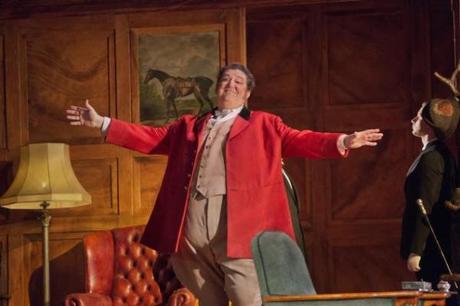
Ambrogio Maestri as Falstaff at the Met (nytimes.com)
Falstaff was Met musical director James Levine’s first radio broadcast in over two years. I am happy to report that he passed the orchestral acid test with flying colors. “Jimmy,” as he’s affectionately known to fans and followers, maintained the light touch this masterful score calls for: there was a delicate refinement throughout his approach. The opera has long been one of Levine’s specialties, and his past experience with the work certainly showed in this performance. There was nothing heavy-handed or bombastic about it, merely the right amount of stop and go, flair and élan. Most of the sillier passages (Falstaff hiding in that humongous laundry basket, for example, or his thrashing at Windsor Park) as well as those few moments of clarity and calm came directly from the music. The audience welcomed Mr. Levine back with vigorous acclamation.
Incidentally, the opera has never been an audience favorite. In fact, the running joke is that Falstaff is more of a connoisseur’s piece than a popular attraction. It’s strictly a communal affair, where every part counts, right down to the lowliest comprimario. The males have a slight edge in that department, but the females follow suit and fall in with the flow. Boito’s rapid-fire lines and Verdi’s lusty accompaniment to his characters’ buffo antics are miracles of ensemble writing. Even more startling are the composer’s musically shortened phrases and brief melodic signatures, which paved the way for the coming verismo movement. In Falstaff, his final word on the state of Italian opera, the aged Verdi finally got his chance to mock the operatic conventions he himself had been loathed to employ. He not only mocked them, he revolutionized and modernized them as well — Italian opera 2.0.
My own view is that Falstaff is two-thirds of an excellent score, with lively banter and judicious vocal displays at both extremes (particularly those for baritone). However, I find that Verdi lost inspiration as he reached Act III, which is unnecessarily long and drawn out and takes the wind out of the previous act’s sails. He’s also repetitive and unimaginative, a rarity for this composer — we can blame Boito for that oversight. He knew better than to play it slow and loose, where fast and furious would be the key.
But it’s here, at the opera’s finale, that Verdi redeemed himself by foisting upon his audiences a fabulous fugue, one of the oldest of all musical forms. He has the entire cast come up to the footlights to render their verdict on all that’s transpired before: “Tutto nel mondo è burla” they sing – literally “Everything in the world is a joke,” but more commonly translated using Shakespeare’s famous line from As You Like It, “All the world’s a stage,” which brings the opera full circle.
With his rotund form, imposing height and huge girth, baritone Ambrogio Maestri (love that first name!) showed himself to be a natural-born Falstaff. Blessed with comic timing and a burnished darkness to his timbre, Maestri embodied the corpulent knight as few singers have — no extra padding needed for this fleshy performer! Vocally, he struck a balance between the “fat” tone of a Giuseppe Taddei, his illustrious predecessors from the past, and the commendable diction of a Tito Gobbi. There was also something of the older style of such exponents as Giuseppe Valdengo (in the famed Toscanini recording), and especially the classic portrayal by Mariano Stabile. I noticed a slight beat in the highest reaches of Maestri’s voice, along with a tendency to approach his notes from below. Otherwise, his delightful renditions of “Va, vecchio John” and “Quand’ero paggio” were some of the finest singing of this part in many a year.

Franco Vassallo (left) as Ford & Maestri as Falstaff (Ken Howard)
He was ably partnered by Franco Vassallo as the excitable Master Ford. A smooth-sounding vocal presence, the young Milanese baritone reminded one of Rolando Panerai, who made a specialty out of this part in several well-regarded LPs (Panerai’s Falstaff in those recordings were the aforementioned Gobbi and Taddei). Vassallo sang the Jealousy aria with plenty of bite and variety, which held the audience’s interest — not an easy thing when surrounded by such talent. Ford is a high-lying part usually given to artists on the rise: Lawrence Tibbett made a tremendous impression in it at the Met, as did Leonard Warren after him.
The main distinction of this work, however, is the unprecedented sequence for two baritones in Act II, nowhere in evidence in any of Verdi’s previous output. Ford warbles an ersatz coloratura phrase that sharp-eared listeners may have picked up as a nod to Princess Eboli’s Song of the Veil (“Canzone del velo”) from the massive Don Carlo. It’s as if the old man were chuckling to himself at the ridiculousness of this little inside joke.
Musicologists are fond of repeating the old saw that Falstaff and Ford were modeled on Fra Melitone from Verdi’s La Forza del Destino. Indeed, Melitone’s surly mannerisms and feisty ways set the right pattern for how Verdi would ultimately compose the music for the above-named characters. Going against the accepted grain, however, my feelings are that Verdi, writing a full five years after Otello (another Shakespearean-adapted drama), based the personalities of Falstaff and Ford on those of the musically closer Iago and Otello, with Ford playing the part of the obsessed Moor (again, the Jealousy angle in “È sogno o realtà?” – “Is this a dream or reality?”), and Falstaff as a rather cartoonish Iago (his Honor monologue, “L’onore, ladri,” with its brassy orchestration clearly aping Iago’s “Credo”; plus his third-act drinking bout, “Va, vecchio John” – “Go on, old rascal John,” with its mounting trills in the woodwinds and evocation of Iago’s warning to Otello to beware the “green-eyed monster”). Both Vassallo and Maestri excelled in this episode, neither artist giving ground to the other.
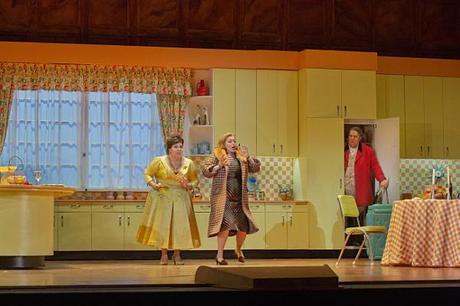
Angela Meade (left) as Alice Ford, Jennifer Johnson Cano as Meg Page, with Falstaff (minnesotapublicradio.org)
Stephanie Blythe was an immensely gratifying Mistress Quickly, that ample contralto voice of hers completely filling the auditorium. Her comically exaggerated repetitions of “Reverenza” (“Your reverence”), each one keenly defined and tellingly differentiated, were just one of the many vocal thrills provided by this fine singer. She was every bit the equal of Maestri’s Sir John. Soprano Angela Meade, who triumphed earlier this season in Bellini’s Norma, sang Alice Page. This is more of an ensemble part. Oddly, Verdi gave Alice no solo numbers, only a spurious “love” scene with the enamored Falstaff in Act II. Surely this was luxury casting at its best. I only wish there were more moments for Meade to shine.
Paolo Fanale’s Fenton, sweet-toned and refined, had trouble with his high notes in the early going, but he did get to deliver the last tenor aria Verdi ever wrote, the lovely “Dal labbro” number in the Windsor Park sequence. He complemented the Nanetta of soprano Lisette Oropesa quite nicely, while she got to serenade audiences with her ravishing Act III aria, “Sul fil d’un soffio etesio” – “On the breath of a fragrant breeze.” As for the other cast members, Carlo Bosi was a blustery, fuming and fussing Dr. Caius, Keith Jameson as Bardolfo and Christian Van Horn as Pistola made Falstaff’s disloyal retainers into a vocal odd couple, while mezzo Jennifer Johnson Cano capably captured Meg Page’s efforts to thwart Sir John’s amorous advances.
Some final thoughts on both Rigoletto and Falstaff: that dazzling quartet from Act III of Rigoletto, “Bella figlia dell’amore” (“Beautiful child of love”), is comprised of two separate duets joined together as one piece — two individual slices of action occurring simultaneously yet bound together by Verdi’s sublime score. While the Duke attempts to seduce Maddalena, Gilda weeps at her unfaithful lover, as Rigoletto gives voice to the operatic equivalent of “I told you so.”
Several years later, composer Giacomo Puccini attempted the same trick with his double duet from (wonder of wonders) Act III of La Bohème: Rodolfo tries to convince Mimì to stay with him until the spring, while Marcello and Musetta engage in a lover’s quarrel over her flirtatious behavior with a potential customer. Coincidentally or not, Puccini’s first international hit, Manon Lescaut, debuted at La Scala on February 1, 1893, followed a week later (on February 9) by the master’s final opera Falstaff.
We’ve been hinting at this all along, whereby the end of an older era in Italian opera would be prefaced by the birth of a newer one. And if ever a man were born for the job of Verdi’s successor, Puccini was most assuredly that man. Rigoletto had blazed the trail; Falstaff both ended and expanded it. We’ll be hearing Puccini’s three most popular works, Tosca, Madama Butterfly and La Bohème, later in the season, which I look forward to reporting. Until then, a happy holiday to all!
Copyright © 2013 by Josmar F. Lopes

